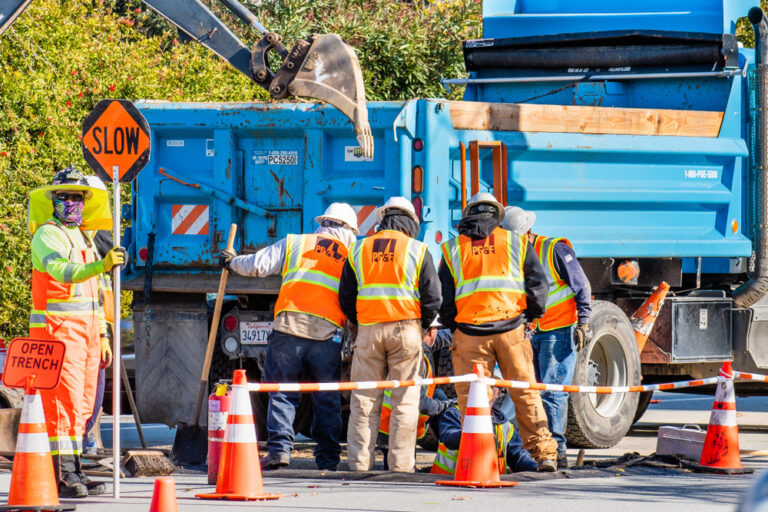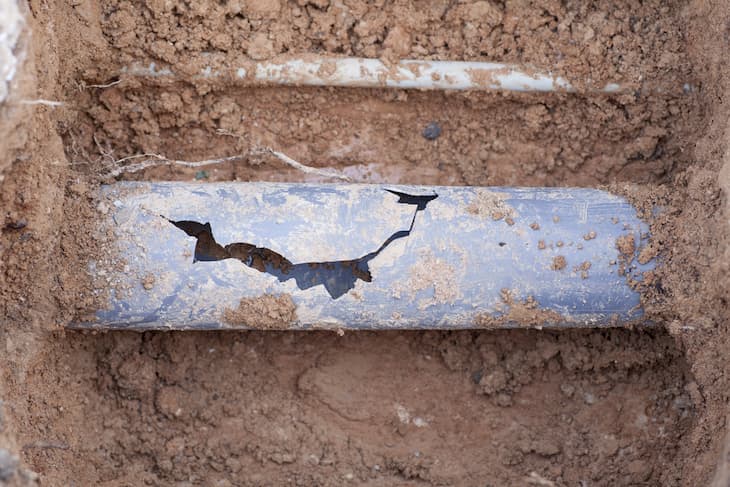When a sewer line breaks near your home, you may be tempted to assume that the city is responsible for the repair. This is not, however, always the case so it’s important to understand who replaces a sewer line when it becomes damaged.
Keep reading to find out more about damaged sewer lines, who is responsible, and how to carry out repairs or replacements.
How to Tell If You Have a Damaged Sewer Line
Because sewer lines are buried underground and out of sight, recognizing the signs of a damaged line means looking at the interior and exterior of your home.
Here are a few signs of a damaged sewer line:
- The smell of sewage or gas
- Slow draining in your sinks and toilet
- Clogs and backups in your sinks and toilet
- Lush, green grass in your yard (lusher and greener than normal)
- Sogginess or pooling water in your yard
- Mold and mildew on your home’s ceilings, walls, or floors
- Broken slabs and wall cracks
If you notice any of these signs, it’s important to contact a professional sewer technician right away. They can help determine if the issue is a simple clog or significant damage to your home’s sewer line.
When is the City Responsible for Sewer Lines?
You may have been told that the city is responsible for maintaining and fixing pipes that run from your property line to the municipal water main while you are responsible for the lines that run from the property line into your home. This is not entirely accurate and the responsibility for repairing damaged sewer lines depends on whether the damage has occurred in the upper or lower lateral pipes.
The city is only responsible for the sewer line that starts at the main underground sewer pipe – the one that carries waste and wastewater to the city’s treatment plant. Homeowners are expected to maintain any pipes that connect to this main sewer line.
There are two sections of pipe that run from your home to the main sewer line: upper lateral pipes and lower lateral pipes.
The upper lateral pipe is the one that deals with the clean-out of your house and property. The lower lateral line runs from your property to the main sewer line. This often causes controversy when it comes to who is responsible for repairing damage since the lower lateral line may not be located directly under your property but remains your responsibility.
Simply put, you as a homeowner are responsible for any sewer line repairs when it comes to the area that begins at the upper lateral pipe and ends at the lower lateral pipe. Everything else is up to the city.
Sewer Line Repair
When the replacement and repair of a damaged sewer line falls on the municipality, the city will send a maintenance crew to carry out these tasks. If you are responsible for replacing a damaged sewer line, you need to first have the issue inspected to determine the problem and its location.
Sewer line damage can be expensive to remediate, especially if a replacement is necessary. However, some problems can be fixed with a sewer line cleaning or a simple repair. Before you haul out your wallet, make sure to contact a licensed sewer technician. They can use specialized equipment, such as a drain camera, to properly diagnose the issue.
If a replacement or repair is inevitable, and the issue exists in the lower lateral pipe, the city may have become involved if the problem is occurring under the road or sidewalk. In this case, you are still responsible for the repair costs.
Does Homeowner’s Insurance Cover Damaged Sewer Lines?
Whether or not your homeowner’s insurance covers damaged sewer lines depends entirely on what is included in your policy.
Recently, a new provision has been made available for home insurance policies called “service line coverage”. This newer coverage will pay for the repair or replacement of exterior underground water and sewer piping when the responsibility for doing so falls on the homeowner. Typically, this coverage will pay for accommodations should you have to leave your home during repairs as well as damage to outside property such as sidewalks, decks, and landscaping.
Keep in mind that you cannot add this coverage to your policy following a sewer line break and file a claim. Speak to your insurance broker about the availability of this policy and add it to your homeowner’s insurance before damage does occur.
How to Clean Up a Sewage Backup in Your Home
The most important thing to do if you are experiencing a sewage backup in your home due to a damaged sewage pipe is to have everyone leave the home to avoid any potential health risks associated with the affected area.
If you are performing the cleanup yourself, be sure to wear personal protective gear such as rubber gloves and boots, eyewear, and a facemask. Pump the sewage out as soon as possible and remove any saturated carpeting, flooring, insurance, etc. Wash down the walls, floors, and surfaces with hot water and disinfectants. Remove any excess water and let the area air-dry within 24-48 hours after the incident to reduce the risk of mold and mildew.
Be sure to contact a professional if the backup occurred more than 24 hours ago or if there’s any possibility that the sewage water may have come into contact with your home’s HVAC system.
Time for the Professionals!
As we mentioned, it’s important to have a licensed sewer technician inspect the damage to the sewer line in order to determine the cause of the issue. This will give you a clearer idea of what steps need to be taken next.
So if you are experiencing sewer line issues in and around your home, it’s time for the professionals! Our team of experts can use specialized equipment such as sewer cameras to get to the root of the issues.


